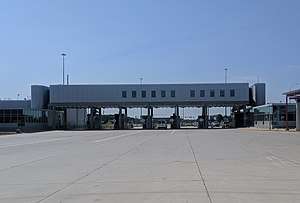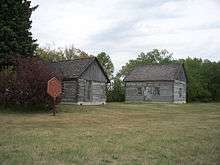Pembina–Emerson Border Crossing
The Pembina–Emerson Border Crossing is a United States-Canada port of entry (POE) that connects the U.S. city of Pembina, North Dakota and the Canadian community of Emerson, Manitoba. On the American side, the crossing is connected by Interstate 29 (I-29) and U.S. Route 81 in Pembina County, while the Canadian side is connected by Manitoba Highway 75 in the Municipality of Emerson – Franklin.
| Pembina–Emerson Border Crossing | |
|---|---|
 Canada-U.S. border crossing at Emerson port of entry in Manitoba | |
| Location | |
| Country | United States; Canada |
| Location |
|
| Coordinates | 49.000477°N 97.237634°W |
| Details | |
| Opened | 1871 |
| US Phone | (701) 825-5800 |
| Canadian Phone | (204) 373-2524 |
| Hours | Open 24 Hours |
| Website www | |
Over one million travelers are processed at this border crossing each year, making it the second busiest of such along the Canada–United States border west of the Great Lakes, behind only the Pacific Highway Border Crossing found between British Columbia and Washington state.[1][2] The Pembina border station is the easternmost in North Dakota, located approximately 300 metres (980 feet) west of the Red River of the North, the state's boundary with Minnesota. A separate border crossing between Emerson and nearby Noyes, Minnesota was in operation until 2006.
The POE sits along an international trade corridor, making it an important commercial port. It is among the top five Canada-US crossings in terms of truck trade value, which was at CA$16.9 billion (approx.) in 2011. Likewise, around 360,000 commercial trucks crossed at this location in that year, which grew to around 400,000 by 2013. This number is forecast to grow by about 58% by the year 2035.[3]:12 The Pembina and Emerson ports also manage the rail inspection stations next to the former Noyes–Emerson East border crossing, where the BNSF Railway connects with the Canadian National Railway and the Canadian Pacific Railway connects with the Soo Line Railroad, its U.S. subsidiary.
History

In 1871, the port of Emerson was established as the first land border customs station in Canada. It was created to protect and ultimately collect duty for trade with the Hudson's Bay Company trading post that was attacked in a Fenian Raid, and subsequently liberated by the U.S. Cavalry earlier that year.[4] Though no longer active, the original customs building in Emerson still stands today.
For many years, there were two roads entering Canada at Emerson: the popular Jefferson Highway (U.S. Route 75) entered from Noyes, Minnesota, and the Meridian Highway (U.S. Route 81) entered from Pembina, North Dakota. All Canada-bound traffic was directed to the brick customs building in downtown Emerson, which has since been converted into the Emerson Health Centre. In the mid-1950s, Canada built separate inspection stations at the border on both roads. The crossing across from Pembina was called "West Lynne"—the name of the small village that had been absorbed by the Town of Emerson in 1883—while the larger crossing across from Noyes was known as "Emerson East."
The modern Pembina-West Lynne border crossing opened in 1964 while I-29 was under construction (the final section of I-29 from Joilette to the border was not completed until 1977). The facilities on the former U.S. Route 81 a short distance to the east were closed and subsequently demolished a few years later. Following the reconfiguration of PTH 75 and PTH 29 in 1985, most U.S.-bound traffic was diverted to the Pembina crossing.
Also located near this crossing is Fort Dufferin, a former Canadian police post and base of the North American Boundary Commission, which surveyed and marked the international border as defined in the Treaty of 1818. During the 1870s, Fort Dufferin also served as a customs and immigration for steamboats entering Canada via the Red River.[5]
Recent History

The Canadian and American governments closed the Emerson East and Noyes border stations in 2003 and 2006, respectively, and merged rail inspection operations with the ports at West Lynne and Pembina. The West Lynne border station was renamed Emerson following the closure of Emerson East in 2003.
Both countries underwent an extensive expansion project, starting in 2017, providing significant upgrades to their facilities, as well as road infrastructure at the Pembina-Emerson Crossing. This was the first renovation project for the U.S. POE since 1996 and for the Canadian POE since 1999.[1]
Illegal immigration
The number of persons crossing the border illegally into Canada (referred to as "irregular migrants") through the Emerson-Pembina-Noyes area has increased significantly following U.S. President Donald Trump's Protecting the Nation from Foreign Terrorist Entry into the United States executive order in January 2017. However, the port had begun to see a considerable increase of irregular migration as of early 2016, prior to the election of Trump.
The increased levels of asylum seekers trying to enter Canada at the Pembina-Emerson and former Noyes-Emerson border crossings and other regions along the international border have garnered international media attention, resulting in the Canadian government renegotiating the Safe Third Country Agreement with the U.S. government.[6][7]
The majority of recent irregular migration has been by migrants from African nations seeking asylum in Canada to avoid potential deportation from the U.S. Although persons claiming refugee status are not permitted to migrate to Canada from the U.S. (or vice versa) under the two countries' Safe Third Country Agreement, asylum seekers who have crossed the border illegally in some cases have been allowed to stay in Canada while their applications are processed.
The practice of crossing the border illegally is not without danger, especially during the cold prairie winter. On December 24, 2016, two Ghanaian men successfully made it across the border by walking several miles along the Red River in sub-zero temperatures. However, both suffered severe frostbite that required amputation of their fingers. In May 2017, a 57-year old Ghanaian asylum seeker died of hypothermia while attempting to cross into Canada via the closed Emerson-Noyes border crossing.[8]
See also
References
- "Border Infrastructure Investment Plan December 2014" (PDF). US Department of Homeland Security. Retrieved 2 March 2017.
- "Border Crossing/Entry Data: Query Detailed Statistics". US Department of Transportation, Bureau of Transportation Statistics. Retrieved 19 January 2016.
- WSP/MMM Group Ltd. 2016. "Southern Red River Valley Review of Trade Route Network and Red River Crossings", final report (May). Government of Manitoba Transportation Systems Planning: https://www.gov.mb.ca/mit/transpolicy/tspd/pdf/rr_valley_transportation_study_final.pdf
- McClelland, James; Lewis, Dan (1975). Emerson 1875-1975 A Centennial History (PDF). Town of Emerson, Manitoba. p. 10. Retrieved 19 January 2016.
- Redekop, Bill (7 December 2008). "When Mounties had to go..." Winnipeg Free Press. Retrieved 28 August 2012.
- "New numbers show spike in asylum seekers crossing from U.S. to Manitoba". cbc.ca. 9 January 2017.
- "Canada, U.S. move to redraft border treaty to cut flow of asylum seekers". The Globe and Mail. 1 April 2019.
- "Body of woman, 57, found near Manitoba border believed to be asylum seeker, U.S. police say". cbc.ca. 30 May 2017.